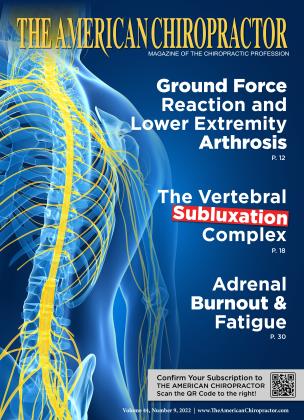Imaging After Trauma is NOT Harmful
September 1 2022 William OwensImaging After Trauma is NOT Harmful
September 1 2022 William OwensA THOROUGH EVALUATION OF A TRAUMATICALLY INJURED patient requires a detailed history, comprehensive neurological/orthopedic-based physical examination and both plain film and advanced imaging procedures. In a recent research study by Roo et al. (2022), the authors stated, “Traffic or occupational related injuries represent a global health issue. According to the World Health Organization, approximately 1.35 million people die each year as a result of traffic accidents and between 20 and 50 million people are left injured or disabled. The global number of non-fatal occupational accidents was estimated at 374 million.(pg 1)
Proper diagnosis and management is critical because mismanagement can accelerate the financial burden to society. The paper continues by stating, “The financial burden on society by those killed or disabled from their injuries is substantial and arise from medical and lost productivity costs.” (pg 1} This paper sought to review injury victims and their imaging profiles, stating, “Data were retrospectively collected from 500 consecutive medicolegal cases for which the principal investigator (PI) of this study was the designated expert radiologist between March 2013 and September 2019.”(pg2) They added, “A total of 2,107 imaging procedures were performed of which 30% were radiographs (n = 631), 21% were CT (n = 438) and 49% were MRI (n = 1,038).” (pg 1}
Understanding radiation dosage and individual imaging studies is important, and the authors reported, “Plain radiography, computed tomography (CT) and magnetic resonance imaging (MRI) are essential imaging techniques for evaluating spinal injuries. In contrast to MRI, which uses radio waves and a strong magnetic field to produce images, radiography and CT expose patients to X-rays.”(ps 1} It is important to provide an accurate diagnosis while being aware of risk factors of exposing injury victims to excessive radiation dosages, particularly with redundant studies.
The authors continue by reporting, “Special attention has to be given to those patients who receive multiple examinations, which is often the case for patients who were in a traffic or occupational accident. Radiation doses are cumulative and although the dose for a single examination might be low, patients undergoing repetitive procedures could reach high cumulative radiation exposures.”(pg 11)
This was an important study because often there is fear that patients are being imaged in excess. This research paper outlined, “In conclusion, accumulated radiation doses after a minor or moderate traffic or occupational accident requiring cervical or lumbar spine imaging are far below 100 mSv [safety threshold]." (pg 6) is first study that outlines radiation dosage in a controlled population and found, when properly used, imaging in trauma victims is safe and effective. Avoiding ordering imaging studies for fear of over-exposure is an irrational approach to spine care and in fact, we would argue, it is the avoidance of medically necessary imaging that truly puts patients at risk.
Dr. William Owens Jr is currently in private practice in Buffalo, NY. His practice employees 4 Doctors of Chiropractic and 2 Doctors of Physical Therapy. He is President and CEO of the National Spine Management Group, LLC and Clinical Director of the Fellowship in Spinal Biomechanics and Trauma. Additionally, Dr. Owens is Adjunct Faculty in Family Medicine at the State University of New York at Buffalo Jacobs School of Medicine and Cleveland University Kansas City, College of Chiropractic. He can be reached at 716.228.3847.
Reference
1. De Roo, B., Bacher, K., & Verstraete, K. (2022). Cervical and lumbar spine imaging after traffic and occupational accidents: Evaluation of the use of imaging techniques, cum ulative radiation dose and associated lifetime cancer risk, European Journal of Radiology, 151, 110293.
 View Full Issue
View Full Issue












